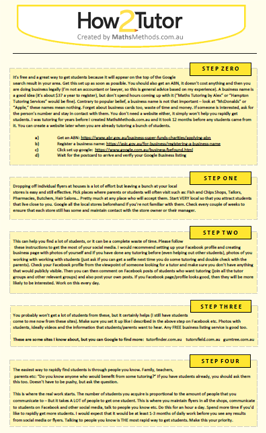There’s a lot you can do to get set up, create a business name, a website, social media, business cards etc etc.
Please don’t do any of this.
If you want to get started rapidly, read this article, then complete the checklist before doing anything else.
First thing is to find students! You have a couple of options here. You can either start working for someone else and receive a wage, which is not a bad way to start, or you can start your own business where you work for yourself, set your own hours and potentially make a lot more money as well as help more students.
If you’re going to look for work, I would just Google a bunch of tutoring companies and applying. You can create a resume but it’s best to call the person who is in charge of hiring (often the owner) and find out if they are looking for any tutors. You may have to contact the same place a few times before they respond.
If you are going to start tutoring on your own, which is what I’ll mainly focus on, the first thing you should do is find a student through people that you know. Friends, parents, teachers or pretty much anyone you know. Simply ask, “Do you know anyone looking for a tutor?”
Find someone to tutor through your contacts. Write a list of everyone you know and start calling or talk to them the next time you see them. You should also ask them, “Do you know anyone else who might benefit from tutoring?” and get the person’s name and phone number.
Call anyone they give you as soon as possible and start the conversation with “Hi my name’s Alex. David said I should give you a call because you might be interested in a tutor for you son.” Don’t say anything else. Let them talk.
If they don’t need tutoring, then find out if they know anyone else who might. Send them a text at the end of the conversation to let them know your name and what subjects your tutor.
Before taking on any students, talk to both the parents and students about their goals and their purpose to study. You can do this over the phone. Make sure you don’t take on any students who are completely unwilling to learn or you have a bad feeling about or don’t feel you can help them. It’s as important for you to choose your students as it is for them to choose you. You shouldn’t reject many (I’ve only passed on a couple of students out of thousands) but you should be willing to.
You should also not ask for too little money. If you feel you want practise, charge nothing for a few lessons. Otherwise, charge at least $40. If you start charging too little, then you will be seen as cheap and will valued less and then it’s difficult to increase your prices. You can have discount for a 2-hour session, such as $70. Find out if they want tutoring at home, what their address is (unless you have a space to deliver tutoring or want to do it in a library or some other public place) and let them know whether you can do in-person or online classes.
In the first lesson find out what they are having difficulty in class right now and help them with it. Then get them ahead of class. Then go back and help them from the start of the subject or on previous topics they’ve struggled with. This will build up their confidence.
I recommend giving them homework and texting them to ensure they are doing it. Part of your job is to ensure they study correctly and that you hold them accountable for what they agree to do.
At the end of the session find out what they learnt and any wins they had from the tutoring session. It may be worth getting them to write it down, one as a testimonial to show other students and also so the student knows what they got from the session.
When you have finished, ask “Do you know anyone else who might benefit from tutoring?” and get the person’s name and phone number. Make sure you call the person that
This is enough to get you started.



Greetings! Very useful advice in this particular article! It is the little changes that produce the greatest changes. Thanks a lot for sharing!